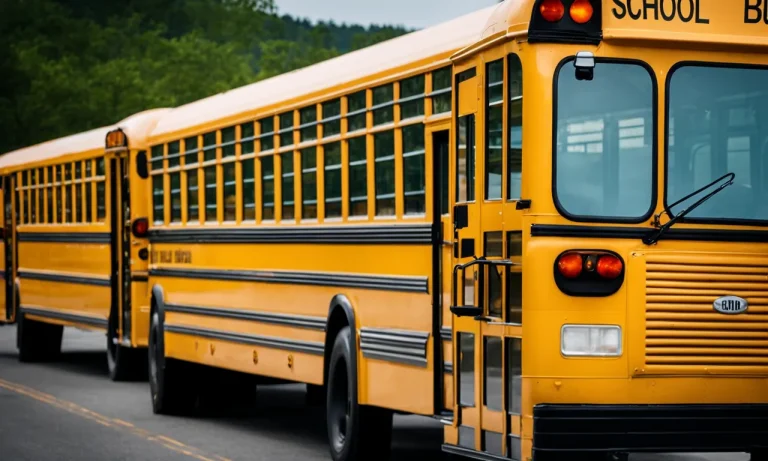Deciding whether or not to switch classes in middle school can be a difficult choice. If you’re looking for a quick answer, here are some valid reasons to request a class change: the material is too easy or challenging, you have a scheduling conflict, you don’t get along with the teacher, or the class isn’t what you expected.
Keep reading to dive deeper into these and other valid justifications for changing your schedule.
Switching classes in middle school is a big decision that requires some thought and planning. This comprehensive guide outlines several valid reasons to request a class change, provides tips for talking to parents and school counselors, and explains the potential drawbacks of switching classes mid-year.
The Course Material is Too Easy or Challenging
One of the valid reasons to switch classes in middle school is when the course material is either too easy or too challenging for a student. This can happen when the class moves at a pace that is not suitable for the student’s learning ability or when the material does not align with their current knowledge level.
The class moves too slowly or quickly
When a class moves too slowly, it can be frustrating for students who are ready to learn at a faster pace. On the other hand, if the class moves too quickly, it can be overwhelming for students who need more time to grasp the concepts.
In both cases, switching to a class that matches the student’s learning speed can greatly benefit their academic progress.
You’ve already mastered the material or are falling behind
It is not uncommon for students to have already mastered the material being taught in a class. In such cases, staying in that class can lead to boredom and a lack of engagement. On the other hand, if a student is struggling to keep up with the material and falling behind, switching to a class where they can receive extra support and guidance can be a wise decision.
The course isn’t intellectually stimulating enough
For some students, a class may not provide the intellectual challenge they crave. They may find the material repetitive or lacking in depth. In such cases, switching to a class that offers a more stimulating curriculum can help students stay motivated and engaged in their studies.
View this post on Instagram
When considering switching classes due to the course material being too easy or challenging, it is important for students to communicate their concerns with their teachers and parents. They can also seek guidance from school counselors who can provide valuable insights and assistance in making the decision.
You Have a Scheduling Conflict
One valid reason to switch classes in middle school is if you have a scheduling conflict. This can happen for a variety of reasons, but the bottom line is that there are two classes that overlap on your schedule.
It could be that both classes are offered at the same time, or that there is simply not enough time in the day to fit them both in.
Two classes overlap on your schedule
If you find yourself in a situation where two classes overlap on your schedule, it can be incredibly frustrating. You may feel torn between two subjects that you are interested in or need to take for your future goals.
In this case, it is definitely worth considering switching one of the classes to a different time slot so that you can successfully attend both classes without any conflicts.
You need a specific class to meet graduation requirements
Another valid reason to switch classes in middle school is if you need a specific class to meet graduation requirements. Sometimes, you may realize that you are missing a required class for your intended high school track or career path.
In this situation, it is important to switch classes in order to ensure that you are on track to meet your goals and graduate on time.
The class time interferes with extracurriculars
Lastly, if the class time interferes with your extracurricular activities, it may be necessary to switch classes. Participating in extracurriculars can be a valuable part of your middle school experience, and it is important to have the freedom to pursue your interests outside of the classroom.
If a class is causing a conflict with your extracurricular schedule, it is worth exploring options to switch to a different class that will allow you to balance both academics and extracurriculars effectively.
View this post on Instagram
Personality Clashes with the Teacher
One valid reason to consider switching classes in middle school is when there are personality clashes with the teacher. This can occur when your learning styles don’t mesh well with the teaching style of the instructor.
Each student has their own unique way of learning and understanding material, and sometimes a teacher’s methods may not align with that.
Your learning styles don’t mesh well
It is essential for students to have a positive and conducive learning environment where they can thrive. If you find that the teacher’s approach does not resonate with your learning style, it may be challenging for you to fully engage and comprehend the material.
For example, if you are a visual learner who benefits from visual aids or diagrams but the teacher mainly relies on lecture-style teaching, it could hinder your ability to grasp the concepts effectively.
The teacher has unrealistic expectations
Another situation that might warrant switching classes is when the teacher has unrealistic expectations. While challenging students academically is important, it is equally crucial for teachers to set realistic goals that are attainable for students.
If you consistently find yourself feeling overwhelmed or constantly falling short of the teacher’s expectations, it can be demotivating and potentially hinder your overall learning experience.
You don’t feel comfortable asking questions
Feeling comfortable and confident enough to ask questions is an essential part of the learning process. However, if you feel intimidated or discouraged by the teacher’s response when you ask for clarification or seek help, it can be detrimental to your academic growth.
Switching classes can provide an opportunity for you to find a teacher who fosters a supportive and open learning environment, where your questions are encouraged and valued.
Remember, switching classes should not be taken lightly, and it is essential to have open communication with both your parents and school administrators to ensure that it is the best decision for your academic journey.
The Class Isn’t What You Expected
One valid reason to switch classes in middle school is if the class you signed up for isn’t what you expected. Sometimes, the description of the class may be misleading, causing you to have false expectations.
For example, if you were expecting a hands-on science class but it turns out to be mostly lecture-based, it may not align with your preferred learning style. It’s important to feel engaged and excited about the subject matter, as this can greatly impact your motivation and overall success in the class.
The description was misleading
It can be frustrating when the description of a class doesn’t accurately reflect what you’ll be learning or doing. Perhaps the class was described as a creative writing workshop, but it turns out to be focused more on grammar and punctuation.
If you were hoping to unleash your imagination and explore different writing styles, this misleading description can leave you feeling disappointed. In such cases, it makes sense to switch to a class that aligns better with your interests and goals.
It’s not challenging or interesting enough
Another valid reason to switch classes is if the class isn’t challenging or interesting enough for you. Middle school is a time when you start discovering your passions and interests, and it’s important to pursue subjects that excite you.
If you find yourself constantly bored or unengaged in a particular class, it may be worth considering a switch. Remember, learning should be enjoyable and stimulating, so don’t settle for a class that doesn’t provide the level of challenge or interest you desire.
You don’t need it for your career goals
In middle school, you may already have an idea of what you want to pursue in the future. If a class you’re taking doesn’t align with your career goals or interests, it may be a valid reason to switch. For example, if you’re passionate about computer programming and want to become a software engineer, taking a class on woodworking may not be necessary for your future career path.
By switching to a class that is more relevant to your goals, you can make the most of your time and resources in middle school.
Remember, it’s important to communicate your concerns with your parents, teachers, and counselors before making any decisions. They can provide guidance and support as you navigate through your middle school education.
Tips for Requesting a Class Change
Talk to your school counselor first
When considering a class change in middle school, it’s important to start by talking to your school counselor. They are there to help guide you through the process and can provide valuable insight into the options available to you.
They may also be able to address any concerns or questions you have about switching classes.
Be honest about why you want to switch
When requesting a class change, it’s important to be honest about your reasons for wanting to switch. Whether you’re struggling academically, not enjoying the subject, or simply feel like the class isn’t the right fit for you, expressing your true motivations can help ensure that the change is in your best interest.
Honesty is key in finding a solution that suits your needs.
Have alternative classes in mind
Before requesting a class change, it’s a good idea to have some alternative classes in mind. This shows that you have put thought into your decision and have considered other options. Research different classes that align with your interests and goals, and discuss these alternatives with your school counselor.
Having alternatives ready can make the process smoother and increase your chances of finding a class that suits you better.
Get your parents’ support
Having your parents’ support can greatly enhance your chances of successfully switching classes. Talk to them about your concerns and reasons for wanting a change, and ask for their assistance in communicating with the school.
Their involvement and support can help reinforce your request and show the school that you have a strong support system behind you.
Provide documentation if applicable
If you have any documentation that supports your request for a class change, be sure to provide it to the school. This could include medical or psychological reports, academic assessments, or any other relevant documents.
Providing documentation can help the school better understand your situation and make an informed decision about your class change request.
Potential Drawbacks of Switching Classes
May be disruptive mid-semester
One potential drawback of switching classes in middle school is that it can be disruptive, especially if done mid-semester. Changing classes can disrupt the flow of the current class and may require catching up on missed material.
This can be especially challenging for students who struggle with transitions or have difficulty adapting to new environments. It’s important to consider the potential impact on academic performance and social adjustment before making the decision to switch classes.
Won’t have established connections
Another drawback of switching classes is that students won’t have established connections with their classmates and teachers. Building relationships and a sense of community in the classroom is an important aspect of the middle school experience.
Switching classes can make it harder for students to form these connections, which may impact their overall sense of belonging and engagement in school.
Might miss important material
Switching classes can also lead to the possibility of missing important material. Each class has its own curriculum and pace of instruction. If a student switches classes, they may miss out on certain topics or concepts that have already been covered in their previous class.
This can create gaps in their understanding and make it harder for them to keep up with the new class.
No guarantee you’ll get your preferred class
Lastly, one important factor to consider is that there is no guarantee that students will get their preferred class when switching. Middle schools often have limited seats available in specific classes, and the availability of certain classes may be subject to factors such as scheduling conflicts or enrollment limits.
Students may have to settle for alternate choices or classes that may not align with their interests or academic goals.
It’s important for students and parents to weigh the potential drawbacks of switching classes against the potential benefits. Consulting with teachers, guidance counselors, and considering the individual needs and goals of the student can help make an informed decision.
Conclusion
Requesting a class change in middle school can be daunting, but is sometimes necessary. If the course material isn’t at the right level, you have scheduling conflicts, don’t get along with the teacher, or find the class isn’t meeting expectations, these can all be valid reasons to switch.
Have an open conversation with your parents and school counselor, get their support, and be prepared to explain your reasoning. While there are potential downsides, don’t be afraid to advocate for an adjustment to your schedule if you feel it will lead to greater academic success.






